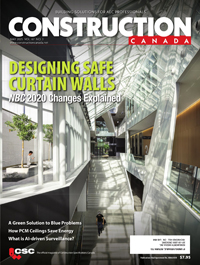Applying the carbon equation to insulating glass units (IGUs)

The presence of materials in the glazing pocket, such as setting blocks, gaskets, and sealants, which are incompatible with the IGU edge seal components can result in premature seal failure as they degrade the edge seal materials (Figure 8). It is not sufficient to ensure compatibility between the glazing materials and the silicone secondary seal, compatibility with the primary seal must also be determined. This is because off-gassed organic vapours from glazing materials can transmit through the silicone, leaving the silicone unharmed, but degrading the primary sealant. It is highly recommended for silicone setting blocks to be specified to address the compatibility risk with this glazing component. IGU sealant manufacturers often provide a compatibility assessment service for other glazing materials, which is a highly recommended service.
Following glazing guidelines issued by the Fenestration and Glazing Industry Alliance (formerly IGMA) and the National Glass Association (formerly GANA) is highly recommended. In addition, there is now a contract glazier certification program, North American Contractors Certification (NACC), which ensures fenestration installers have the quality management programs in place to ensure the effectiveness of their installations (Figure 9).
Implications for specification
IGU service life is a critically important factor in the embodied carbon in buildings and in preserving operational carbon and energy efficiency performance. It is affected by edge seal design and material quality, environmental loads, and fabrication and installation quality. The following are recommendations for specification.
- Manage IGU edge design risk: In addition to requiring compliance to IGU durability standards (e.g. ASTM E2190), ensure a specific spacer(s) type is called out in specifications so it delivers both the thermal performance and durability performance desired. This is especially important when used with a dual-seal PIB/silicone sealant system which is ubiquitous in North American non-residential IGUs. The PHSS spacer category is a sound choice, since it has the thermal performance of a non-metal spacer with the benchmark durability performance of a standard metal box spacer.
- Manage climate load risk: Conduct a climate load analysis of edge seal forces for project specific IGU sizes and make-ups, where small and/or stiff units are anticipated to ensure they are within those qualified by standard IGU weathering standards (e.g. ASTM E2190, CGSB 12.8).
- Manage IGU manufacturing risk: Specify IGU certification for the edge seal material combination which has been specified from high quality certification programs (e.g. IGCC, IGMAC).
- Manage installation risk: Specify glazing contractors certified through the NACC program.
Notes
1 Read “Contextualizing Glass and Carbon Impacts: Addressing Embodied/Operating Carbon with Emerging Glazing Technologies,” Facade Tectonics Institute World Congress, 2022, www.facadetectonics.org/papers/contextualizing-glass-and-carbon-impact.
2 Learn more about “Lifecycle carbon calculation for double-pane and triple-pane glazed windows,” Glass for Europe, April 2022.
3 See Processed Glass EPD, Vitro Architectural Glass. www.vitroglazings.com/media/x4ajs3s2/vitro-epd-processed-glass-products.pdf.
4 Read the report, “25-Year Field Correlation Study Report (1980-2005),” IGMA TR-4000-08, Fenestration and Glazing Industry Alliance (FGIA).
5 To learn more, see “Addressing Embodied Carbon: Managing Insulating Glass Service Life, Facade Tectonics Institute World Congress,” presented at 2022 Facade Tectonics Institute World Congress, www.facadetectonics.org/papers/addressing-embodied-carbon.
6 For more information, see “Strain-Normalized Serviceability Limit State for the Secondary Seal of Insulating Glass Units with Rigid Box Spacer.” Part of ASTM’s Durability of Building and Construction Sealants and Adhesives, 7th Volume, 2022, www.astm.org/stp163320200074.html.
Helen Sanders, PhD, is a general manager at Technoform North America. She has more than 25 years of experience in glass technology, market development, and manufacturing, especially in functional coatings, insulating glass, and thermal zone technology for fenestration. Sanders has a doctorate in surface science from the University of Cambridge, England. She is an active member of many industry organizations and in codes and standards development. She is the founding president of the Facade Tectonics Institute (FTI) and is currently the immediate past president. She is a board member of the National Fenestration Rating Council (NFRC) and the Fenestration and Glazing Industry Alliance (FGIA), co-chair of its Glass Products Council, and of its Innovation and Sustainability Steering Committees; and a technical liaison on the National Glass Association’s (NGA’s) Fabricating Committee. Sanders can be reached via email at helen.sanders@technoform.com.






